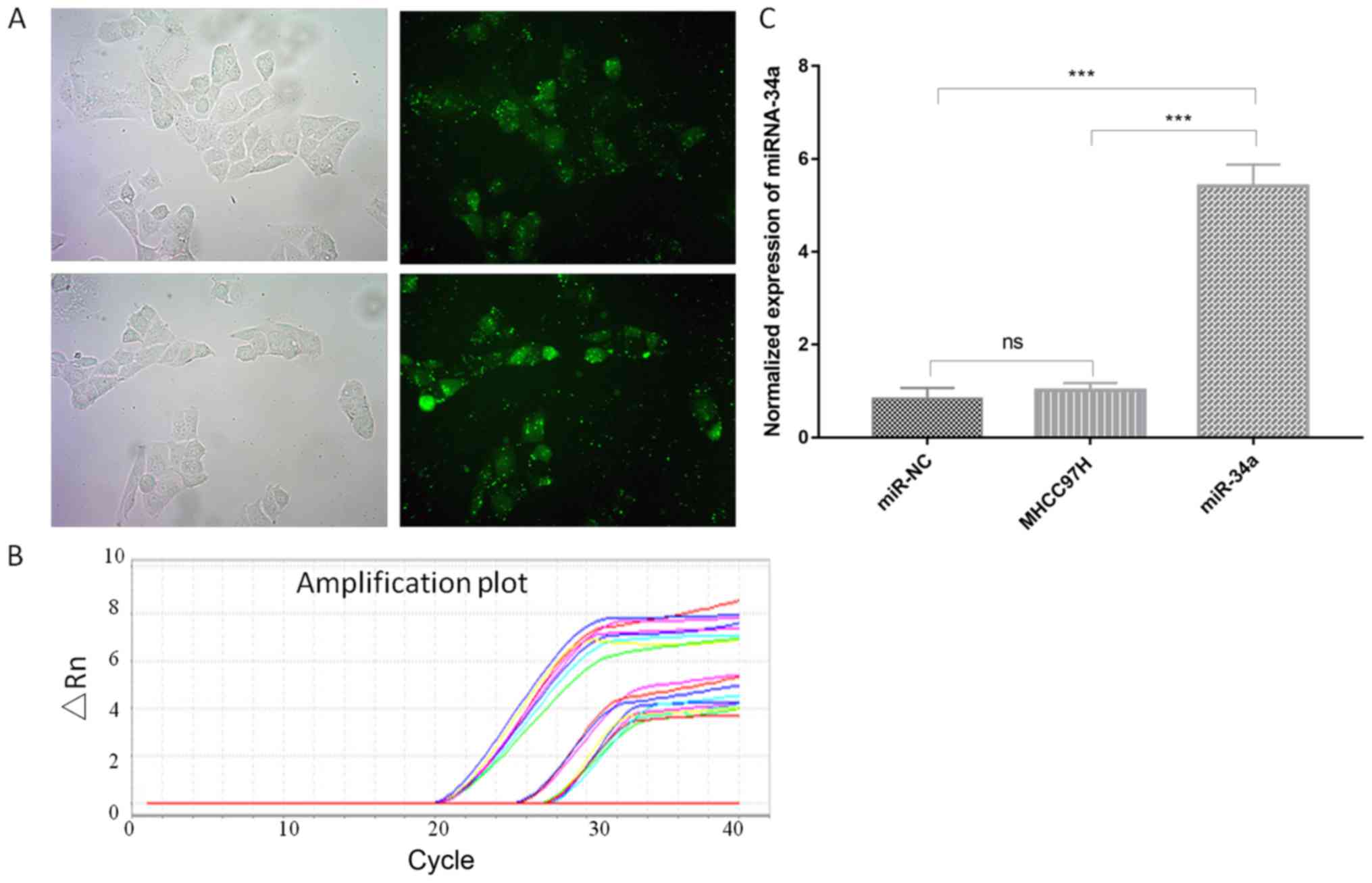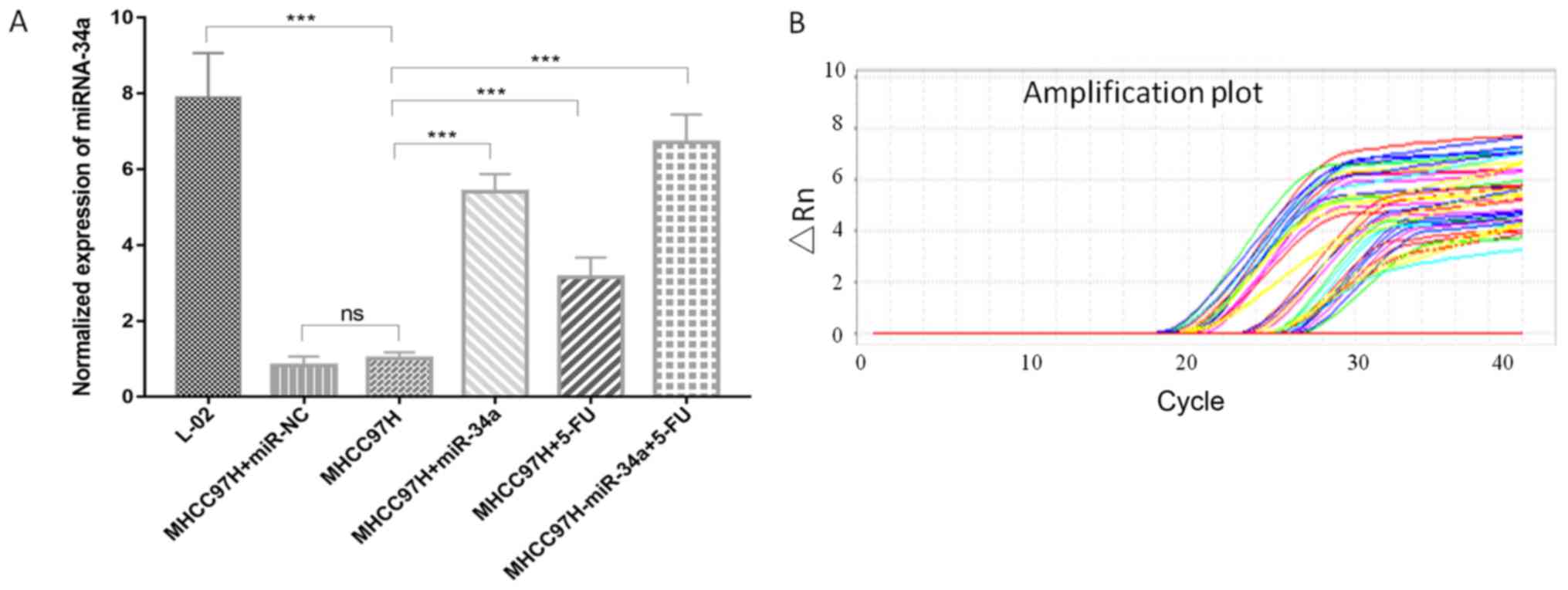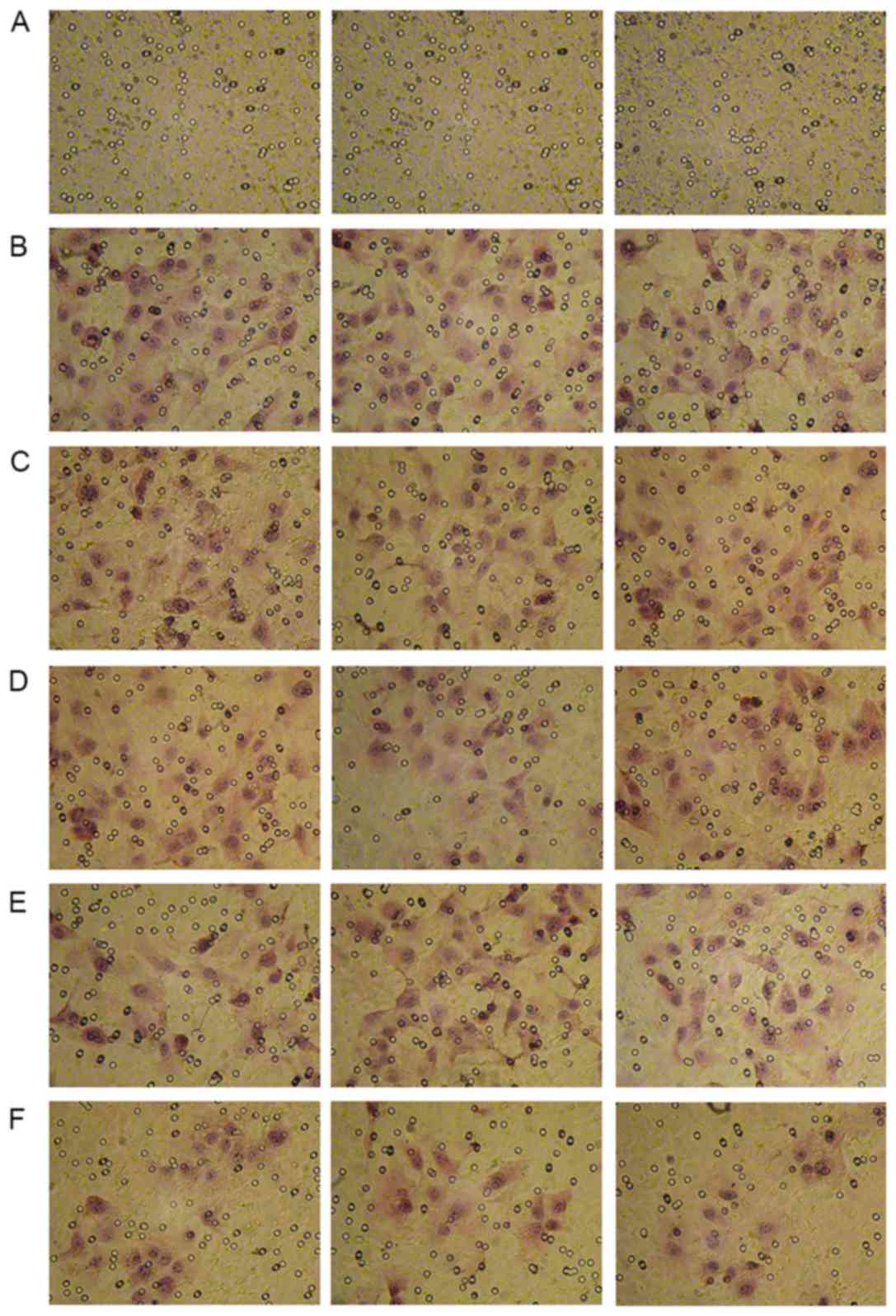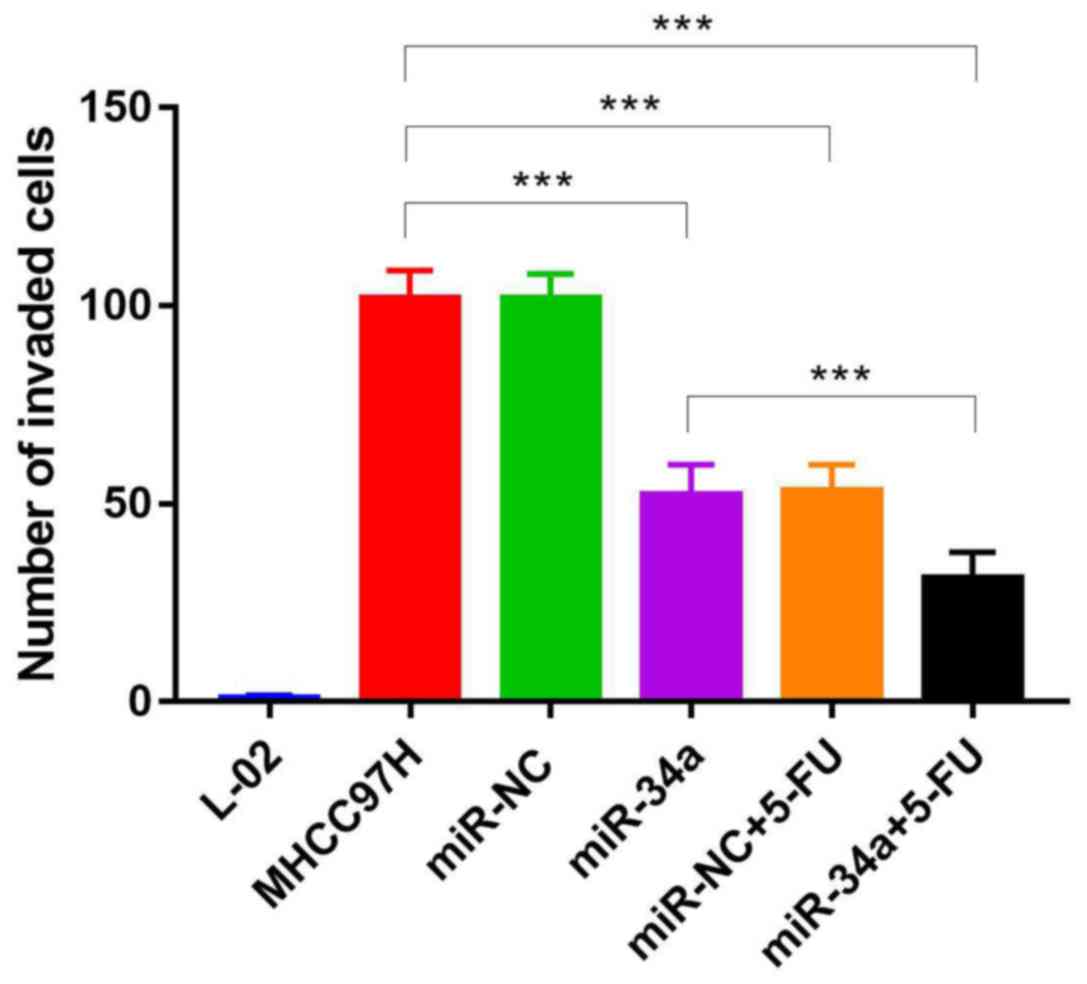MicroRNA‑34a inhibits metastasis in liver cancer cells
- Authors:
- Published online on: October 9, 2018 https://doi.org/10.3892/ol.2018.9555
- Pages: 6960-6965
-
Copyright: © Wei et al. This is an open access article distributed under the terms of Creative Commons Attribution License.
Abstract
Introduction
MicroRNAs (miRNAs/miRs) exist in the majority of eukaryotes and consist of 21–25 nucleotides. miRNAs regulate gene expression via binding to target mRNAs, resulting in mRNA degradation or inhibition of translation (1–4). mRNAs acts as oncogenes or suppressor genes to affect tumor development (5–8). In 2013, Takahashi et al reported that hepatocellular carcinoma (HCC) is the most common primary malignancy of the liver globally (9), and numerous miRNAs are abnormally expressed in HCC (9). miR-21 is one of the most prominently expressed miRNAs in a number of human cancer types, including pancreas, breast, prostate, colon, lung and stomach (10). The expression of miR-21 is increased in HCC tissues, compared with normal tissues (11). However, miR-146a has decreased expression in HCC tissues, compared with normal liver tissues (12). miR-34a is a member of the miR-34 family and has been demonstrated to modulate critical gene transcripts involved in tumorigenesis, but its role in tumorigenesis remains unknown. miR-34a may be activated by p53 to induce apoptosis and inhibit tumor growth (13–16). However, it often dysfunctions or mutates in tumors (17–21). Luo et al (22) has demonstrated that miR-34a was able to suppress the migration of breast cancer cells via targeting Fra-1. Wang et al (23) observed an inverse association between programmed death-ligand 1 (PD-L1) and miR-34a expression in a number of acute myeloid leukemia (AML) samples. miR-34a is a putative binder of the PD-L1-3′ untranslated region (UTR), and overexpression of miR-34a in HL-60 and Kasumi-1 cells could block PD-L1 expression (23). The aim of the present study was to verify the effect of miR-34a on metastasis of liver cancer cells.
Materials and methods
Materials
The miRNeasy Mini kit was purchased from Qiagen GmbH (Hilden, Germany). Real-time PCR detection kit was from GeneCopoeia, Inc., (Rockville, MD, USA). 5-fluorouracil (5-FU) and MTT were from Sigma-Aldrich (Merck KGaA, Darmstadt, Germany). The concentration of 5-FU in the present study was 5 µg/ml, and cells were incubated at 37°C for 48 h. Lipofectamine® 2000 was purchased from Thermo Fisher Scientific, Inc., (Waltham, MA, USA). Minimum Essential Medium (MEM) was from Hyclone (GE Healthcare, Chicago, IL, USA), and fetal bovine serum was from Gibco (Thermo Fisher Scientific, Inc.).
Cell lines and cell culture
MHCC97H liver cancer cells were purchased from the Resource Center of Shanghai Institutes of Biological Sciences (Shanghai, China) were maintained in a monolayer culture at 37°C and 5% CO2 in MEM that was supplemented with 10% fetal bovine serum.
Cell transfection
MHCC97H cells were transfected with 5 mg/ml miR-NC and 5 mg/ml miR-34a mimic (Shanghai GenePharma Co., Ltd., Shanghai, China) using Lipofectamine® 2000 as follows. The cells (4–5×104 cells/ml) were plated in a 6-well plate at 37°C for 24 h. Prior to transfection, the miRNA-Lipofectamine solution was prepared by mixing MEM separately with Lipofectamine or miRNA and then mixing the solutions together. Finally, the miRNA-Lipofectamine solution was added to each well, and the cells were incubated at 37°C for 24–72 h for subsequent analyses.
Reverse transcription-quantitative polymerase chain reaction (RT-qPCR)
All independent experiments were conducted in triplicate. Negative control [no complementary DNA (cDNA)] and RT control (no reverse transcriptase). Total RNA (including miRNA) was extracted using the miRNeasy Mini kit (Qiagen GmbH), and DNA was removed using DNase I. Reverse transcription was conducted with cDNA Synthesis kit (cat. no. 6130; Takara Bio. Inc., Otsu, Japan). Reverse transcription was conducted with 2 µg total RNA, according to the manufacturer's instructions, and the negative control used diethyl pyrocarbonate (DEPC)-treated water instead of the total RNA, the positive control used the control RNA (contained within the cDNA Synthesis kit) instead of the total RNA. In brief, the following reagents were added in turn, 2 µl 10X reaction buffer, 1 µl RiboLock™ Ribonuclease Inhibitor (40 U/µl), DEPC-treated water up to 10 µl and incubated at 37°C for 30 min, and then 1 µl reverse transcriptase (1 U/µl) was added and incubated at 72°C for 5 min. All reagents were contained within the cDNA synthesis kit. qPCR was performed using a SYBR® Premix Ex Taq™ kit (Takara Bio, Inc., Otsu, Japan) on the QuantStudio™ 5 Real-Time PCR system (Applied Biosystems; Thermo Fisher Scientific, Inc.), and with the following primers: miR-34a forward, 5′-TGGCAGTGTCTTAGCT-3′ (10 µM) and reverse, 5′-TGGTGTCGTGGAGTCG-3′ (10 µM); and U6 primer was used as the positive control, U6 forward, 5′-CTCGCTTCGGCAGCACA-3′ (10 µM) and reverse, 5′-AACGCTTCACGAATTTGCGT-3′ (10 µM; all BioSune, Shanghai, China). The final concentration of the primers was 0.4 µM. A 3-step PCR was performed using the SYBR Select Master Mix kit (Applied Biosystems; Thermo Fisher Scientific, Inc.), according to the manufacturer's protocols, and conducted under the following conditions: Initial denaturation at 95°C for 30 sec, followed by a total of 40 cycles were run with a initial denaturation at 95°C for 5 sec, and an annealing temperature at 60°C for 30 sec. Finally, 95°C for 5 sec, and 60°C for 1 min, and 95°C for 5 sec. Relative quantification was analyzed using the 2−∆∆Cq method (24).
Invasion assay
Each Transwell insert was coated with diluted BD Matrigel matrix coating solution (BD Biosciences, Franklin Lakes, NJ, USA) and then incubated at 37°C for 30 min. Cell suspension (5×104 cells/ml) in Opti-MEM® I culture media (Thermo Fisher Scientific, Inc.) with no FBS was prepared. The negative control was cells transfected with miR-NC. Cell suspension (1 ml) was added to each 6-well invasion chamber. Culture media with 20% FBS was placed in each Transwell chamber and incubated in a humidified incubator (37°C, 5% CO2). Matrix and non-invading cells were gently scraped off following 24 h. The cells were fixed with 95% ethanol for 20 min and subsequently stained with hematoxylin at room temperature for 10 min. The membrane was washed with PBS and observed under a fluorescent microscope (Nikon Corporation, Tokyo, Japan). A total of 5 fields (×20) were selected randomly and the number of invaded cells were counted.
Statistical analyses
Experimental data are presented as the mean ± standard deviation. Multiple groups were compared using one-way analysis of variance with SPSS (version 17.0, SPSS, Inc., Chicago, IL, USA) statistical software. P<0.05 was used to indicate significant difference. All independent experiments were conducted in triplicate.
Results
miR-34a expression is promoted by 5-FU
To study the effect of miR-34a on cancer cells, cell lines were transfected with negative miR control (NC) and miR-34a vector. The transfected cells were green (Fig. 1A). The cells that were transfected with miR-34a exhibited a markedly increased miR-34a expression (5.35-fold) compared with non-transfected cells according to RT-qPCR analysis (Fig. 1B and C; Table I). The transfected cells were treated with 5 µg/ml 5-FU to observe miR-34a expression. 5-FU was able to promote miR-34a expression. The cells that were transfected with miR-34a and then treated with 5-FU (MHCC97H-miR-34a+5-FU) were able to express a relatively increased level of miR-34a, compared with the control group (MHCC97H-miR-34a) (Fig. 2 and Table I).
miR-34a inhibits cell invasion
To study the effect of miR-34a on metastasis, invasion analysis of transfected and drug-treated cells was carried out using Transwell assay. The overexpression of miR-34a had a similar effect as 5-FU treatment as both treatments were able to inhibit cell invasion. The mean number of invaded cells in five random fields were 51.36±8.43 in the overexpressed miR-34a group. The mean number of invaded cells in five random fields were 52.11±9.42 in the drug-treated MHCC97H-miR-NC group. While the mean number of invaded cells in five random fields were 30.24±7.85 in the drug-treated MHCC97H-miR-34a group. Furthermore, overexpressing miR-34a was able to increase the effect of 5-FU, leading to reduced cell invasion (P<0.05) (Figs. 3 and 4; Table II).
Discussion
In recent years, miR-34a has been increasingly studied. Previous studies have revealed miR-34a to be decreased in tumors, compared with normal tissue (25). miR-34a is a member of the miR-34 family, and has been demonstrated to modulate critical gene transcripts involved in tumorigenesis, but its role in tumorigenesis remains unknown. miR-34a may be activated by p53 to induce apoptosis and inhibit tumor growth (13–16); however, it frequently causes dysfunctions or mutations in tumors (17–21). Luo et al (22) demonstrated that miR-34a was able to suppress the migration of breast cancer cells via targeting Fra-1. Wang et al (23) observed an inverse association between PD-L1 and miR-34a expression in a number of AML samples. miR-34a, as a putative binder of the PD-L1-3′UTR, overexpression in HL-60 and Kasumi-1 cells could block PD-L1 expression (23). There is hope to utilize miR-34a for diagnosis and therapy. Gallardo et al (26) reported that miR-34 was able to act as a prognostic marker of non-small-cell lung cancer, and Fang et al (27) indicated that miR-34a was able to be used to detect diffuse large B-cell lymphoma. Furthermore, Wiggins et al (28) reintroduced chemically synthesized miR-34a to cancer cells to drive a therapeutic response. The results of the present study also suggested that overexpressing miR-34a, which was depleted in cancer cells, was able to inhibit cell invasion. According to its importance in tumorigenesis, chemically synthesized miRNA mimic may be used to simulate endogenous miRNA to target genes and inhibit tumor development.
Acknowledgements
Not applicable.
Funding
No funding was received.
Availability of data and materials
The datasets used and/or analyzed during the current study are available from the corresponding author on reasonable request.
Authors' contributions
WW and HT contributed in the design of the study, developed the methodology, collected the data, performed the experiments, analysis and wrote the manuscript; LT contributed to the design of the study, critically revised the manuscript and approved the final version to be published. All authors agreed to be accountable for all aspects of the study.
Ethics approval and consent to participate
Not applicable.
Patient consent for publication
Not applicable.
Competing interests
The authors declare that they have no competing interests.
References
|
Berezikov E, Cuppen E and Plasterk RHA: Approaches to microRNA discovery. Nat Genet. 38 (Suppl):S2–S7. 2006. View Article : Google Scholar : PubMed/NCBI | |
|
He L and Hannon GJ: MicroRNAs: Small RNAs with a big role in gene regulation. Nat Rev Genet. 5:522–531. 2004. View Article : Google Scholar : PubMed/NCBI | |
|
Neely LA, Patel S, Garver J, Gallo M, Hackett M, McLaughlin S, Nadel M, Harris J, Gullans S and Rooke J: A single-molecule method for the quantitation of microRNA gene expression. Nat Methods. 3:41–46. 2006. View Article : Google Scholar : PubMed/NCBI | |
|
Shyu AB, Wilkinson MF and van Hoof A: Messenger RNA regulation: To translate or to degrade. EMBO J. 27:471–481. 2008. View Article : Google Scholar : PubMed/NCBI | |
|
Callis TE, Chen JF and Wang DZ: MicroRNAs in skeletal and cardiac muscle development. DNA Cell Biol. 26:219–225. 2007. View Article : Google Scholar : PubMed/NCBI | |
|
Croce CM: Causes and consequences of microRNA dysregulation in cancer. Nat Rev Genet. 10:704–714. 2009. View Article : Google Scholar : PubMed/NCBI | |
|
Giannakakis A, Coukos G, Hatzigeorgiou A, Sandaltzopoulos R and Zhang L: miRNA genetic alterations in human cancers. Exp Opin Biol Ther. 7:1375–1386. 2007. View Article : Google Scholar | |
|
Hatfield S and Ruohola-Baker H: microRNA and stem cell function. Cell Tissue Res. 331:57–66. 2008. View Article : Google Scholar : PubMed/NCBI | |
|
Takahashi K, Yan I, Wen HJ and Patel T: microRNAs in liver disease: From diagnostics to therapeutics. Clin Biochem. 46:946–952. 2013. View Article : Google Scholar : PubMed/NCBI | |
|
Volinia S, Calin GA, Liu CG, Ambs S, Cimmino A, Petrocca F, Visone R, Iorio M, Roldo C, Ferracin M, et al: A microRNA expression signature of human solid tumors defines cancer gene targets. Proc Natl Acad Sci USA. 103:2257–2261. 2006. View Article : Google Scholar : PubMed/NCBI | |
|
Tomimaru Y, Eguchi H, Nagano H, Wada H, Tomokuni A, Kobayashi S, Marubashi S, Takeda Y, Tanemura M, Umeshita K, et al: MicroRNA-21 induces resistance to the anti-tumour effect of interferon-α/5-fluorouracil in hepatocellular carcinoma cells. Br J Cancer. 103:1617–1626. 2010. View Article : Google Scholar : PubMed/NCBI | |
|
Karakatsanis A, Papaconstantinou I, Gazouli M, Lyberopoulou A, Polymeneas G and Voros D: Expression of microRNAs, miR-21, miR-31, miR-122, miR-145, miR-146a, miR-200c, miR-221, miR-222, and miR-223 in patients with hepatocellular carcinoma or intrahepatic cholangiocarcinoma and its prognostic significance. Mol Carcinog. 52:297–303. 2013. View Article : Google Scholar : PubMed/NCBI | |
|
Bommer GT, Gerin I, Feng Y, Kaczorowski AJ, Kuick R, Love RE, Zhai Y, Giordano TJ, Qin ZS, Moore BB, et al: p53-mediated activation of miRNA34 candidate tumor-suppressor genes. Curr Biol. 17:1298–1307. 2007. View Article : Google Scholar : PubMed/NCBI | |
|
Chang TC, Wentzel EA, Kent OA, Ramachandran K, Mullendore M, Lee KH, Feldmann G, Yamakuchi M, Ferlito M, Lowenstein CJ, et al: Transactivation of miR-34a by p53 broadly influences gene expression and promotes apoptosis. Mol Cell. 26:745–752. 2007. View Article : Google Scholar : PubMed/NCBI | |
|
Raver-Shapira N, Marciano E, Meiri E, Spector Y, Rosenfeld N, Moskovits N, Bentwich Z and Oren M: Transcriptional activation of miR-34a contributes to p53-mediated apoptosis. Mol Cell. 26:731–743. 2007. View Article : Google Scholar : PubMed/NCBI | |
|
Tarasov V, Jung P, Verdoodt B, Lodygin D, Epanchintsev A, Menssen A, Meister G and Hermeking H: Differential regulation of microRNAs by p53 revealed by massively parallel sequencing: miR-34a is a p53 target that induces apoptosis and G1-arrest. Cell Cycle. 6:1586–1593. 2007. View Article : Google Scholar : PubMed/NCBI | |
|
Ichimura A, Ruike Y, Terasawa K, Shimizu K and Tsujimoto G: MicroRNA-34a inhibits cell proliferation by repressing mitogen-activated protein kinase kinase 1 during megakaryocytic differentiation of K562 cells. Mol Pharmacol. 77:1016–1024. 2010. View Article : Google Scholar : PubMed/NCBI | |
|
Di Martino MT, Leone E, Amodio N, Foresta U, Lionetti M, Pitari MR, Cantafio ME, Gullà A, Conforti F, Morelli E, et al: Synthetic miR-34a mimics as a novel therapeutic agent for multiple myeloma: In vitro and in vivo evidence. Clin Cancer Res. 18:6260–6270. 2012. View Article : Google Scholar : PubMed/NCBI | |
|
Li L, Xie X, Luo J, Liu M, Xi S, Guo J, Kong Y, Wu M, Gao J, Xie Z, et al: Targeted expression of miR-34a using the T-VISA system suppresses breast cancer cell growth and invasion. Mol Ther. 20:2326–2334. 2012. View Article : Google Scholar : PubMed/NCBI | |
|
Pang RT, Leung CO, Lee CL, Lam KK, Ye TM, Chiu PC and Yeung WS: MicroRNA-34a is a tumor suppressor in choriocarcinoma via regulation of Delta-like1. BMC Cancer. 13:252013. View Article : Google Scholar : PubMed/NCBI | |
|
Guessous F, Zhang Y, Kofman A, Catania A, Li Y, Schiff D, Purow B and Abounader R: microRNA-34a is tumor suppressive in brain tumors and glioma stem cells. Cell Cycle. 9:1031–1036. 2010. View Article : Google Scholar : PubMed/NCBI | |
|
Luo YP, Zhou H, Krueger J, Kaplan C, Liao D, Markowitz D, Liu C, Chen T, Chuang TH, Xiang R and Reisfeld RA: The role of proto-oncogene Fra-1 in remodeling the tumor microenvironment in support of breast tumor cell invasion and progression. Oncogene. 29:662–673. 2010. View Article : Google Scholar : PubMed/NCBI | |
|
Wang X, Li J, Dong K, Lin F, Long M, Ouyang Y, Wei J, Chen X, Weng Y, He T and Zhang H: Tumor suppressor miR-34a targets PD-L1 and functions as a potential immunotherapeutic target in acute myeloid leukemia. Cell Signal. 27:443–452. 2015. View Article : Google Scholar : PubMed/NCBI | |
|
Livak KJ and Schmittgen TD: Analysis of relative gene expression data using real-time quantitative PCR and the 2(-Delta Delta C(T)) method. Methods. 25:402–408. 2001. View Article : Google Scholar : PubMed/NCBI | |
|
Thor T, Künkele A, Pajtler KW, Wefers AK, Stephan H, Mestdagh P, Heukamp L, Hartmann W, Vandesompele J, Sadowski N, et al: miR-34a deficiency accelerates medulloblastoma formation in vivo. Int J Cancer. 136:2293–2303. 2015. View Article : Google Scholar : PubMed/NCBI | |
|
Gallardo E, Navarro A, Viñolas N, Marrades RM, Diaz T, Gel B, Quera A, Bandres E, Garcia-Foncillas J, Ramirez J and Monzo M: miR-34a as a prognostic marker of relapse in surgically resected non-small-cell lung cancer. Carcinogenesis. 30:1903–1909. 2009. View Article : Google Scholar : PubMed/NCBI | |
|
Fang C, Zhu DX, Dong HJ, Zhou ZJ, Wang YH, Liu L, Fan L, Miao KR, Liu P, Xu W and Li JY: Serum microRNAs are promising novel biomarkers for diffuse large B cell lymphoma. Ann Hematol. 91:553–559. 2012. View Article : Google Scholar : PubMed/NCBI | |
|
Wiggins JF, Ruffino L, Kelnar K, Omotola M, Patrawala L, Brown D and Bader AG: Development of a lung cancer therapeutic based on the tumor suppressor microRNA-34. Cancer Res. 70:5923–5930. 2010. View Article : Google Scholar : PubMed/NCBI |













